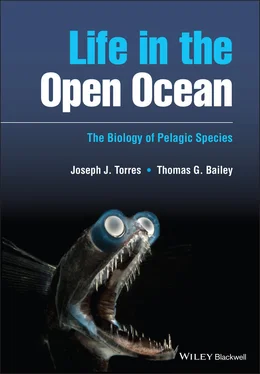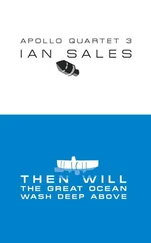Joseph J. Torres - Life in the Open Ocean
Здесь есть возможность читать онлайн «Joseph J. Torres - Life in the Open Ocean» — ознакомительный отрывок электронной книги совершенно бесплатно, а после прочтения отрывка купить полную версию. В некоторых случаях можно слушать аудио, скачать через торрент в формате fb2 и присутствует краткое содержание. Жанр: unrecognised, на английском языке. Описание произведения, (предисловие) а так же отзывы посетителей доступны на портале библиотеки ЛибКат.
- Название:Life in the Open Ocean
- Автор:
- Жанр:
- Год:неизвестен
- ISBN:нет данных
- Рейтинг книги:5 / 5. Голосов: 1
-
Избранное:Добавить в избранное
- Отзывы:
-
Ваша оценка:
- 100
- 1
- 2
- 3
- 4
- 5
Life in the Open Ocean: краткое содержание, описание и аннотация
Предлагаем к чтению аннотацию, описание, краткое содержание или предисловие (зависит от того, что написал сам автор книги «Life in the Open Ocean»). Если вы не нашли необходимую информацию о книге — напишите в комментариях, мы постараемся отыскать её.
Life in the Open Ocean: The Biology of Pelagic Species
Life in the Open Ocean: The Biology of Pelagic Species
Life in the Open Ocean — читать онлайн ознакомительный отрывок
Ниже представлен текст книги, разбитый по страницам. Система сохранения места последней прочитанной страницы, позволяет с удобством читать онлайн бесплатно книгу «Life in the Open Ocean», без необходимости каждый раз заново искать на чём Вы остановились. Поставьте закладку, и сможете в любой момент перейти на страницу, на которой закончили чтение.
Интервал:
Закладка:
The right of Joseph J. Torres and Thomas G. Bailey to be identified as the authors of this work has been asserted in accordance with law.
Registered Offices John Wiley & Sons, Inc., 111 River Street, Hoboken, NJ 07030, USA John Wiley & Sons Ltd, The Atrium, Southern Gate, Chichester, West Sussex, PO19 8SQ, UK
Editorial Office 9600 Garsington Road, Oxford, OX4 2DQ, UK
For details of our global editorial offices, customer services, and more information about Wiley products visit us at www.wiley.com.
Wiley also publishes its books in a variety of electronic formats and by print‐on‐demand. Some content that appears in standard print versions of this book may not be available in other formats.
Limit of Liability/Disclaimer of Warranty The contents of this work are intended to further general scientific research, understanding, and discussion only and are not intended and should not be relied upon as recommending or promoting scientific method, diagnosis, or treatment by physicians for any particular patient. In view of ongoing research, equipment modifications, changes in governmental regulations, and the constant flow of information relating to the use of medicines, equipment, and devices, the reader is urged to review and evaluate the information provided in the package insert or instructions for each medicine, equipment, or device for, among other things, any changes in the instructions or indication of usage and for added warnings and precautions. While the publisher and authors have used their best efforts in preparing this work, they make no representations or warranties with respect to the accuracy or completeness of the contents of this work and specifically disclaim all warranties, including without limitation any implied warranties of merchantability or fitness for a particular purpose. No warranty may be created or extended by sales representatives, written sales materials or promotional statements for this work. The fact that an organization, website, or product is referred to in this work as a citation and/or potential source of further information does not mean that the publisher and authors endorse the information or services the organization, website, or product may provide or recommendations it may make. This work is sold with the understanding that the publisher is not engaged in rendering professional services. The advice and strategies contained herein may not be suitable for your situation. You should consult with a specialist where appropriate. Further, readers should be aware that websites listed in this work may have changed or disappeared between when this work was written and when it is read. Neither the publisher nor authors shall be liable for any loss of profit or any other commercial damages, including but not limited to special, incidental, consequential, or other damages.
Library of Congress Cataloging‐in‐Publication Data
Names: Torres, Joseph J., 1950– author. | Bailey, Thomas G., 1945– author. | Wiley‐Blackwell (Firm), publisher.
Title: Life in the open ocean : the biology of pelagic species / Joseph J Torres, Thomas G Bailey.
Description: Hoboken, NJ : Wiley‐Blackwell, 2022. | Includes bibliographical references and index.
Identifiers: LCCN 2021021994 (print) | LCCN 2021021995 (ebook) | ISBN 9781405145299 (cloth) | ISBN 9781119840305 (adobe pdf) | ISBN 9781119840312 (epub)
Subjects: LCSH: Marine biology. | Oceanography.
Classification: LCC QH91 .T67 2022 (print) | LCC QH91 (ebook) | DDC 577.7–dc23
LC record available at https://lccn.loc.gov/2021021994LC ebook record available at https://lccn.loc.gov/2021021995
Cover Design: Wiley
Cover Image: © Danté Fenolio
From JJT – To my family, near and far – especially mom and dad and my lovely wife Linda for her incredible patience with me and our other family member: the book.
From TGB – To my lovely wife, Jan for her love and support through the years.
From Both of Us
To our mentors, Charlotte Mangum, Jim Childress, George Somero, and Bruce Robison, a constant source of inspiration to this day.
And especially to Linda M. Torres, our gatekeeper, editor, and Angel of Detail, for keeping us on the straight and narrow, and without whom this book would still be “in preparation.”
Preface
Most of the planet earth (over 60% of it) is deep ocean. Within the oceanic realm are two basic ecosystems, the ocean bottom, a two‐dimensional environment containing creatures that creep, crawl, burrow, or lie in wait for prey, and the immense, three‐dimensional pelagic region that lies above it, the largest living space on the planet, containing the swimmers and drifters. The deep ocean bottom has been the focus of a lot of excitement over the last 50 years, with many expeditions to the fabulous communities inhabiting the hydrothermal vents at our planet’s oceanic ridges. More recently, the thrilling discovery of deep coral reefs off Australia has captured the public eye, showing that still more oceanic discoveries may yet await us.
More fascinating yet are the communities of marine animals that inhabit the oceans’ pelagic realm, and the creatures’ adaptations to an environment devoid of barriers to movement in three‐dimensional space. Many people are familiar with the term “plankton,” the tiny plants and animals that drift with the ocean currents. More are familiar with the large pelagic species such as tuna, sharks, and swordfish, not only from pictures or fishing trips but also from the dinner table. The large, highly capable swimming species like tuna and sharks are termed “nekton.” In between the tiny drifters and the strong swimmers are an entire community of animals that are familiar mainly to oceanographers but are the critical link between the small and the large. Animals in the intermediate community are not as capable at swimming as the tunas but are better at it than the small zooplankton. Collectively, the creatures are known as the micronekton and macrozooplankton, and they make up one of the largest animal communities on planet earth.
The nekton, micronekton, and macrozooplankton include a variety of different animal groups. Several different families of fishes are represented, many with unusual adaptations such as light organs like fireflies, huge gapes to allow them to swallow prey larger than themselves, and large tubular eyes. Among the invertebrates are shrimp similar to the ones we enjoy in shrimp cocktails and other crustaceans that can produce clouds of biological light or live inside jellyfishes. Among the jellies are species larger than a meter across and those that can double their population size in a matter of days by reproducing asexually.
The blue water pelagic community is truly fascinating. The problem is, to learn about the wonders we have briefly described above, you currently need to access many sources. Life in the Open Ocean: The Biology of Pelagic Species gathers the information available on the wide array of taxa making up the pelagic community and presents it as one cohesive whole. It is a synthesis of the information available on the biology of all the groups you will see if you tow a scientific trawl net between the surface and bathypelagic depths. When you bring the net up and look at your catch, you are looking at a community of coexisting species with each group having its own way of solving the problems posed by nature. The book combines basic information about the different animal groups as well as their different strategies for solving natures’ challenges.
Topics covered in the book include basic physical oceanography, properties of water, physical variables that covary with depth such as light, temperature, and pressure and how animals have adapted to cope with each. Animal groups covered in depth (no pun intended) include the Cnidaria, or stinging jellies, the ctenophores or comb jellies, pelagic nemerteans, pelagic annelids, the Crustacea, the Mollusca including the “swimming snails” and cephalopods, the invertebrate chordates, including the salps, pyrosomes, and larvaceans, and lastly, the incredible fishes, focusing on the micronekton but also including the sharks, tunas, mackerels and mahi‐mahi.
Читать дальшеИнтервал:
Закладка:
Похожие книги на «Life in the Open Ocean»
Представляем Вашему вниманию похожие книги на «Life in the Open Ocean» списком для выбора. Мы отобрали схожую по названию и смыслу литературу в надежде предоставить читателям больше вариантов отыскать новые, интересные, ещё непрочитанные произведения.
Обсуждение, отзывы о книге «Life in the Open Ocean» и просто собственные мнения читателей. Оставьте ваши комментарии, напишите, что Вы думаете о произведении, его смысле или главных героях. Укажите что конкретно понравилось, а что нет, и почему Вы так считаете.












